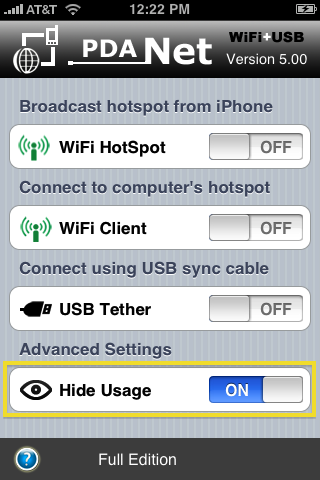If you cast your minds back a couple of months, you’ll remember how we told you that AT&T had begun clamping down on people using tethering on their iPhones without paying for the upgraded tethering plan. Emails and SMS messages were sent informing customers that if they continued to tether they would be charged for it. At the time we weren’t sure how AT&T knew which people were actually tethering, but now we do and more importantly, we know how to get around it.
Today iPhoneDownloadBlog pointed out a snippet from a post over on AndroidPolice that is of particular interest to unauthorized iOS tethering users. Turns out they know how AT&T was able to tell when customers were tethering.
“Jailbroken iPhones typically use the same tethering technique as a standard iPhone, the one that’s already present in iOS. This method exposes tethering activity quite readily, because the iPhone, when in tethering mode, sends traffic through an alternate APN (AT&T access point/router) for the express purpose of identifying the traffic as tethered data. This makes it extremely easy for AT&T to identify whether or not an iOS device is utilizing tethering, and just how much of their data is consumed via tethering.
Some tethering applications for iOS make use of alternative methods and route tethered traffic through the phone’s normal data APN, but by and large, most jailbreakers stick with the stock application because it’s easy to use and doesn’t require any complicated setup. In fact, many iPhone users jailbreak for the sole purpose of avoiding AT&T’s tethering fees (for why, see next section). These are the people AT&T’s is going after.”
So it appears, apps that use the special data APN get noticed by AT&T’s systems, hence the strong-arm tactics. Popular jailbreak app MyWi works just as described by AndroidPolice – using the tethering APN. What we need is an app that uses the same APN as your iPhone does for its own data. According to the iPhoneDownloadBlog, that app is PdaNet.

The latest version of PdaNet comes complete with an option specifically for hiding tethering from AT&T – presumable this option changes the APN the app uses for routing data. TetherMe is another app that appears to be one AT&T can’t track, though PdaNet does seem to be the best bet if you want to avoid your carrier’s tethering charges.
So, if you’re not too keen on paying for your data twice, jailbreak your iPhone and give PdaNet a whirl – it’s available via Cydia right now.
You will, of course, need to have a jailbroken iPhone, iPad or iPod touch to install it. Follow our step by step guide posted here to jailbreak your iPhone, iPad or iPod touch with Redsn0w on iOS 4.2.1 (or untethered with GreenPois0n RC5), or on iOS 4.3.1 with Redsn0w, PwnageTool 4.3 (untethered | tethered), or with Sn0wbreeze on Windows, or on iOS 4.3.2 with Redsn0w, PwnageTool 4.3 (tethered), or with Sn0wbreeze on Windows, or on iOS 4.3.3 using Redsn0w, PwnageTool, Sn0wbreeze on iPhone, iPad and iPod touch if you haven’t already.
[Update]
MyWi developers Intelliborn have reached out to us to give us an update on the situation. Apparently they do not, and have never used a separate APN for tethering which means their users can’t be spotted by the carriers any more than those of other apps. Could it just be that MyWi users have felt the brunt of AT&T’s wrath just because there are so many of them to aim at? Send enough emails to enough people and chances are at least some of them will be using MyWi!
Thanks for the heads-up, Mario.
Check out our iPhone Apps Gallery and iPad Apps Gallery to explore more apps for your iPhone, iPad and iPod touch.
You can follow us on Twitter or join our Facebook fanpage to keep yourself updated on all the latest from Microsoft, Google and Apple.

